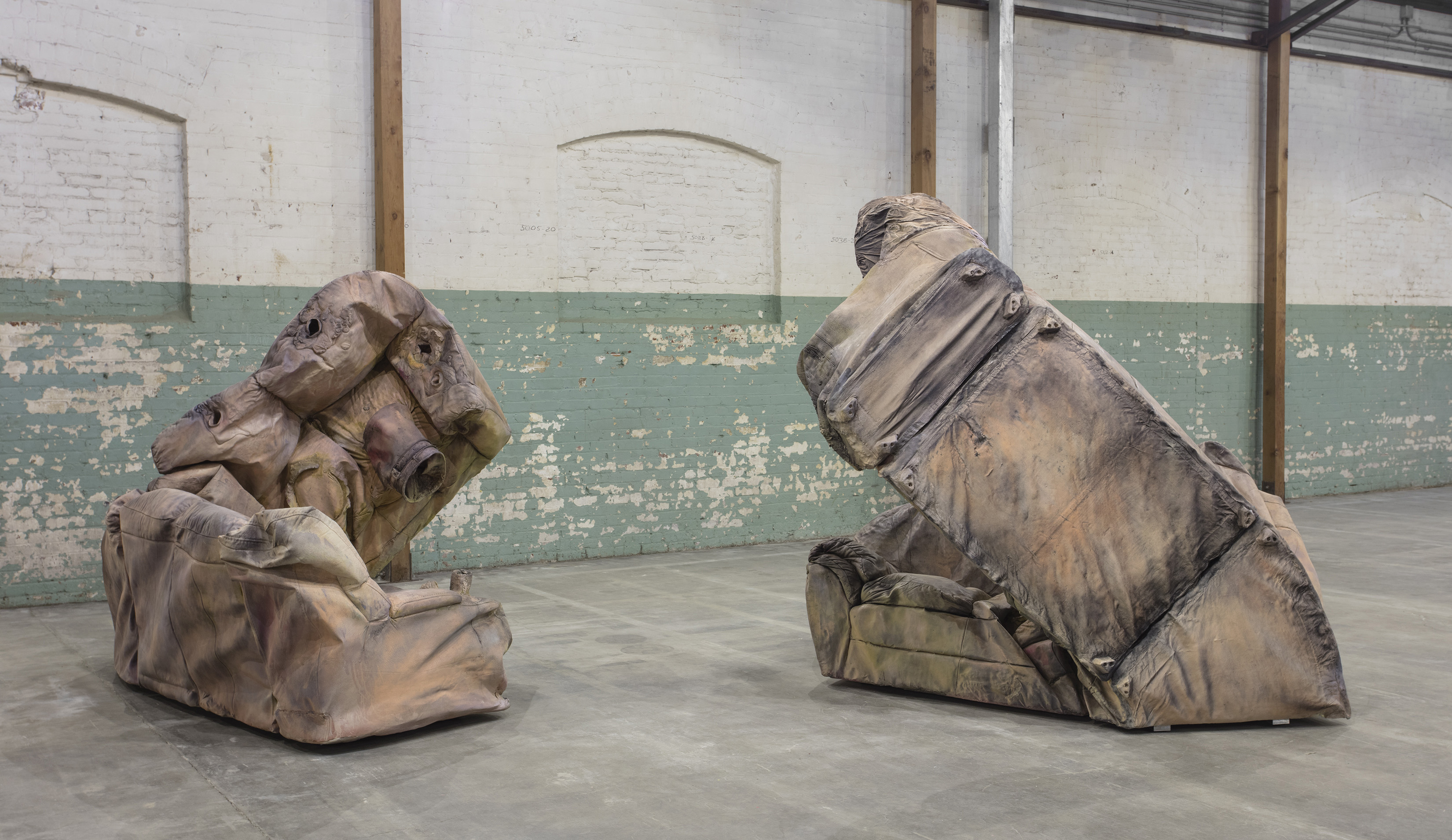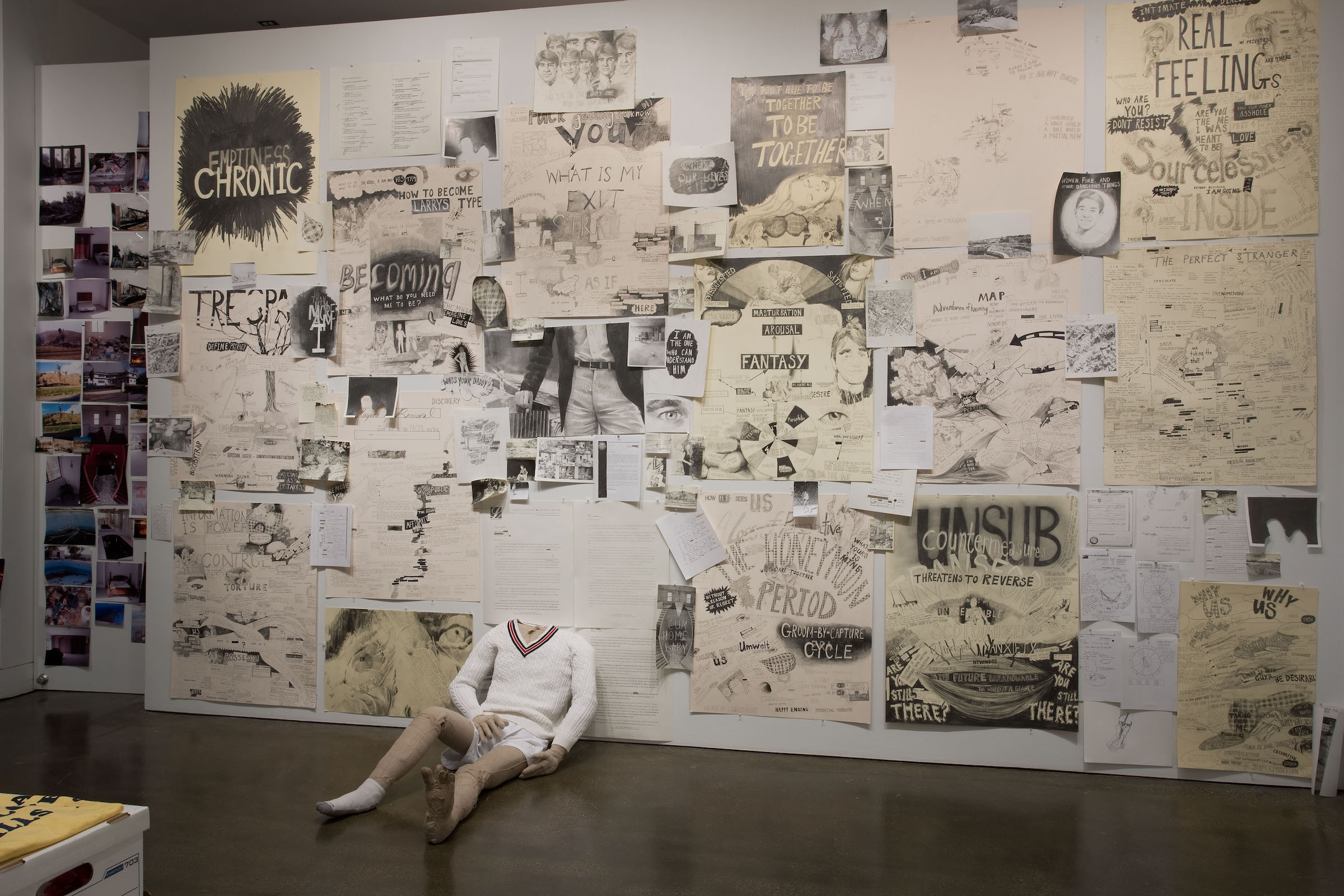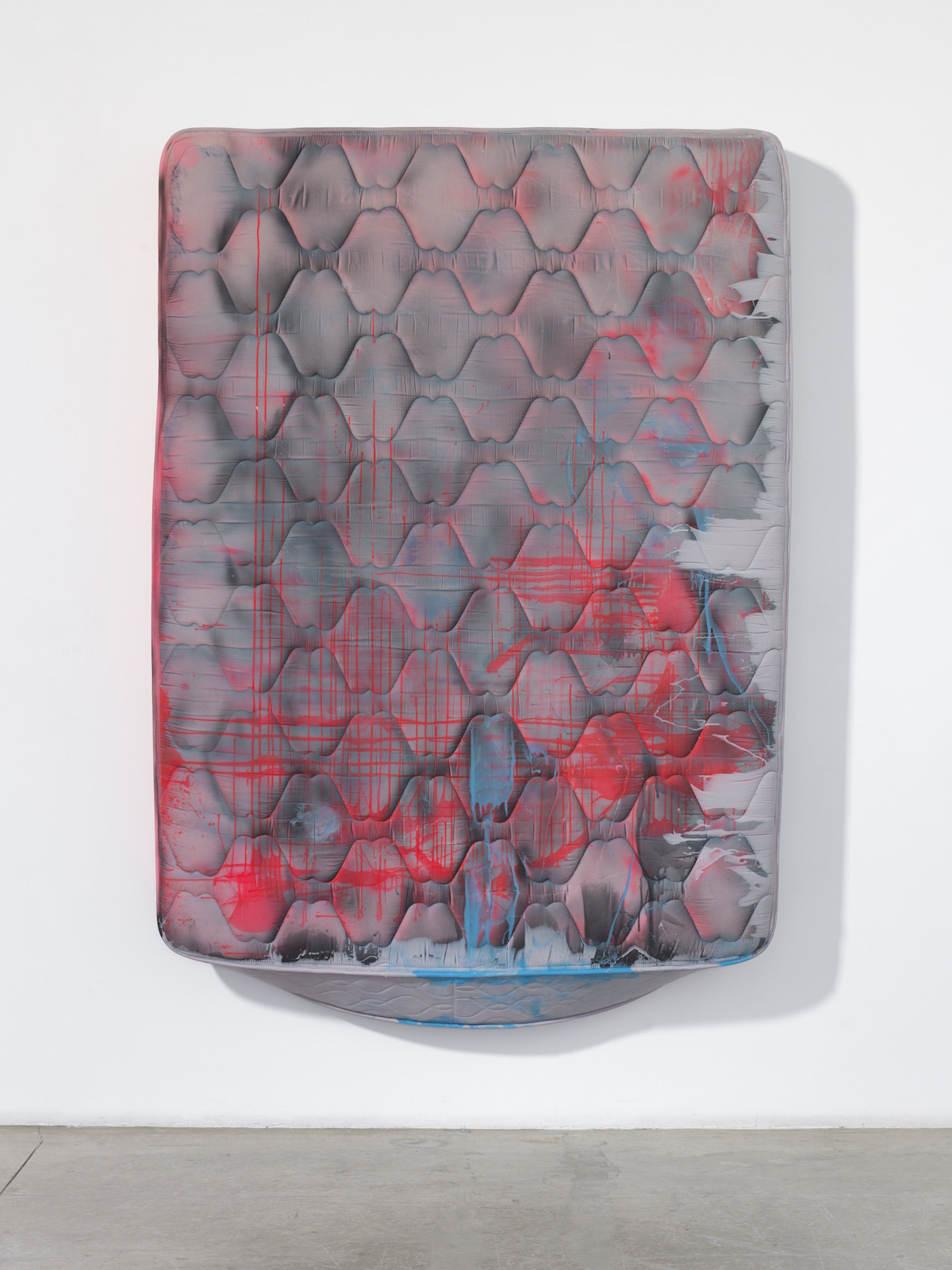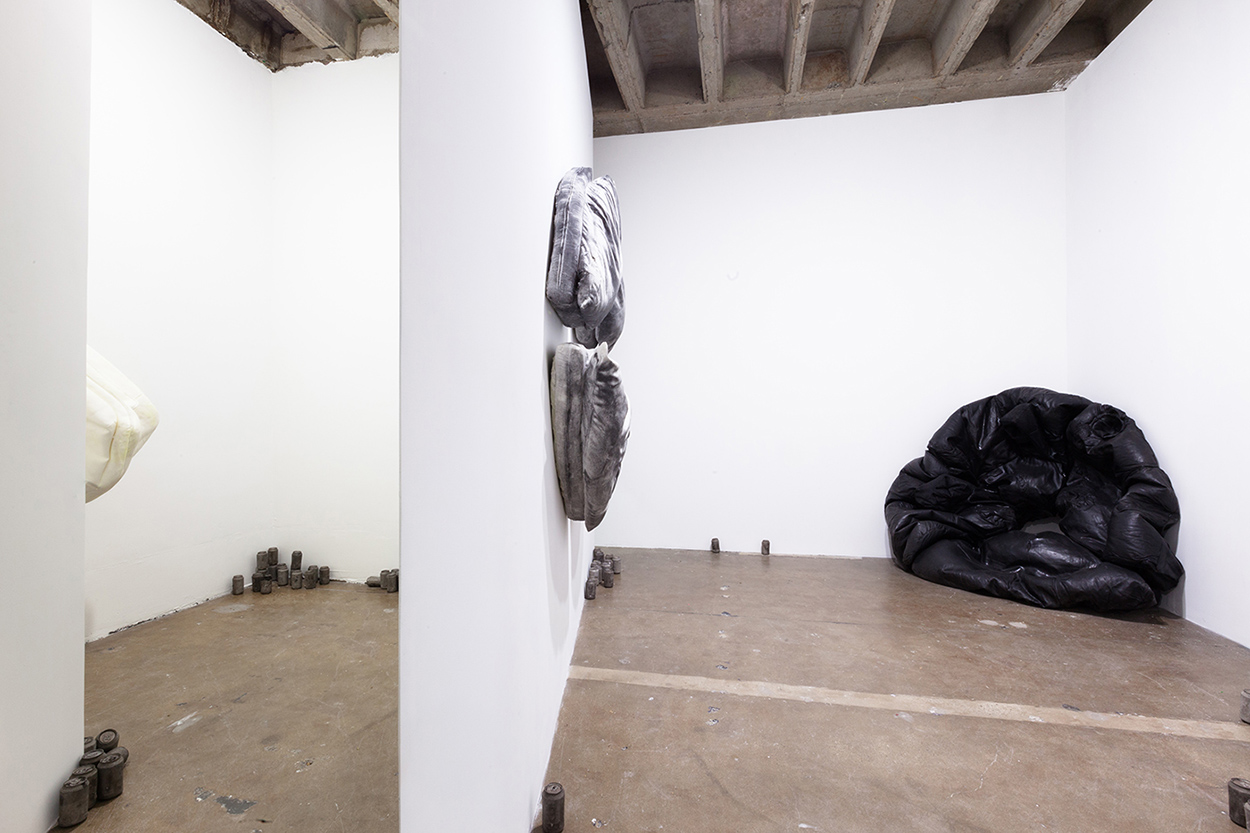An interview with Kaari Upson

Kaari Upson. Left Brace Erase, Back Brace Face. 2016. View of “Revolution in the Making: Abstract Sculpture by Women, 1947–2016.” Hauser Wirth & Schimmel, Los Angeles. Courtesy the artist and Hauser & Wirth. Photo: Brian Forrest.
In 2005, while still a student at CalArts, Kaari Upson began a prodigious, open-ended examination into the life of a man she has never met. Two years previously, she’d walked into the abandoned, foreclosed McMansion next door to her parents’ house, and there, between two different wildfires, she found reams of letters and legal documents — plus a mattress in every room. The occupant of that ersatz Playboy Mansion became the absent heart of Upson’s all-absorbing “Larry Project,” which saw the artist produce paintings of Larry, videos of Larry, even a full-scale Larry doll. The theme of absent bodies continues in her more recent silicone casts of beds and couches, whose tumescent forms can feel at once despondent and lecherous.
Upson was born in San Bernardino, Calif., in 1972, and began her career as a painter; her recent mattress casts, she tells me pointedly, see her returning to objects with “four sides and a face.” When I arrive at her Koreatown studio, she and three assistants are fussing over a ratty sectional sofa out back in the garden. One gent has got a welder’s mask on; Upson wears a Japanese denim apron, and jets constantly between the studio, the office, and the outdoor workshop. If her commodious, corporeal art stands in the proud lineage of Paul McCarthy, Mike Kelley, and other Los Angeles malefactors, there is, in the most recent resin works, a painterliness that can feel almost Apollonian. × Jason Farago
As passionate as I am about your most recent work, there’s really no way not to begin at the beginning — with your “Larry Project,” and its genesis at the house next door to your parents’ home.
I was working on this project as my MFA thesis at CalArts. I was taking a class with a French film theorist, Bérénice Reynaud, and the only class she was teaching that semester was about women who kill. It was the best way to enter film theory. I grew up seeing not one film. The first film I ever saw was Bambi, in a theater. And the next time I went to the movie theater, my boyfriend — I was probably 15 at the time — took me to see Blue Velvet. My family just did not go to the movies. We didn’t even have VHS; we only had Betamax. And we had like two channels, because they didn’t want TV. I spent a lot of time outdoors as a child.
Were your parents hippies?
The opposite. Gun-toting. My mother’s German, and she loves America. She thinks America is just the greatest. Whereas my dad is an old cowboy, who thinks the good old days were when you could leave your front door unlocked. He doesn’t think that good old days were the civil rights movement. It eliminates nostalgia.
I have to admit, I’m pathetically ignorant about San Bernardino.
Good, it’s a good place to be ignorant about. It has one of the highest murder rates per capita in the United States. Someone from my high school posted on Facebook: “Look at where we’re at. We’re number 1 in Southern California for violence.” That’s where I grew up. And not just crime, but natural violence—there’s a lot of fires, windstorms, mudslides. I started to think about it recently: as a child, having all of that come at you, real violent stuff, a terrible fire…. I don’t think my brother ever recuperated from it mentally. That necessity of that brimming danger. You almost need it. Like anything, you get habituated to a certain volume of life.
So “women who kill” was just the right pitch for an intro film course.
If you look at any of the female personas that I’ve taken, in videos or performances, they came from Bérénice Reynaud’s class. She would list them: there is a set number of female roles in film. Caretaker, castrator, mother, wife, whore. She would just list them, and I would write it down. And I would take on one.
My first video in the Larry Project was called As Long As It Takes—Part I: The Head (2007). It seems arbitrary that I’m dressed up as a nurse in a weird gingham face mask. But those archetypal women’s roles were the starting point. I would just take on what was already available in film. I would see from my own angle what would happen.

You were, however, channeling these archetypes through something from your real life, through your next-door neighbor.
But not real. He wasn’t my neighbor, he was my parents’ neighbor. I know of him only through my parents; I was living in New York, and I’ve never seen him in the physical realm. By the time I moved back to go to school at CalArts, he was supposed to be in jail. When the first fire came about, that didn’t burn the house down, but it allowed me to access it. It was empty, uninhabited, but it had beds all over the floor. Boxes. Weird objects everywhere. And I just photographed it. That’s the closest I ever got to him.
How much time passed between the first and second fires?
I think two years. My mom went back to the fire department and got the incident report.
It’s interesting that you were in this feminist film course at precisely this moment when this fantasy of masculinity — this cut-rate Hugh Hefner — is going on in your parents’ backyard. The timing seems crazy.
It’s not that weird, though, when you think about it. When I was very young, no one in my family sat around talking about sex at all. I was introduced to sex through Playboy, and little weird articles on lesbianism and soft S&M. It was in my dad’s bathroom. I didn’t have an opinion about it. I didn’t know if it was bad or good, but I probably knew I was reading something I shouldn’t.
Paul Preciado has written a whole book on Playboy and architecture. Hefner hated to go outside. Just when the feminist movement is saying that the home is not the woman’s domain, Hefner makes the house into a male sex fantasy.
And Larry was obsessed with Hefner. He recreated himself off of Hefner’s image. And Hefner himself says he’s only a creation of his own image. It’s a hall of mirrors!
At this point, were you still thinking of yourself as a painter?
Oh, I am such a painter! I went into CalArts as a straight painter, New York-trained, and there were a few teachers who were notoriously anti-painting. They barely let me in.
What painters were you looking up to when you were first thinking about art? Was it very 80s?
Yeah, Eric Fischl.
Clemente?
No, not Clemente — let’s draw a line! I loved Francis Bacon, Goya, and then very immediately loved Guston. He is still one of my favorite artists; that stuff still surprises me.
As much as I thought I was a painter, though, there was one artist I couldn’t shake, and that was Paul McCarthy. The first exhibition I ever saw was “Helter Skelter” [a renowned exhibition of LA artists, presented in 1992 at MOCA] when I was 19, and I saw Paul McCarthy’s Garden. I moved to New York when I was 21 and saw every work of his that I could. Teepee and Indian (1995-96), The Saloon (1995-96).... I saw that at 22 or 23, and I was overwhelmed. Seeing the body taken apart creates such an anxiety in people.
How did you go about putting flesh on this unknown neighbor?
One of the things I had was his handwriting. Notes and such. I got in touch with the woman who wrote The Complete Idiot’s Guide to Handwriting Analysis — you know, those orange books — and asked her to analyze it. She was British, and as we were chatting, I asked her how people use handwriting analysis, aside from determining authenticity. She told me that the British corporations use it all the time for “compatibility reports.” To see if you fit in. Or that you’re not psychotic.
So I asked this woman to do a compatibility report. It’s a relationship now. I started to realize that I was merging with him. The first installation at school was called the “honeymoon period” — I had just formed a fictive relationship with him.
I had already been rebuilding Larry’s body as a doll based on measurements from a traffic ticket, and thinking about his photographs. I was still incorrect about all kinds of things; I built the doll with blue eyes, but he does not have blue eyes. My dad has blue eyes. (Larry is the exact same age as my dad.) Then I was doing paintings of the doll’s head, paintings of this photograph, portraits over and over again, thinking of Oskar Kokoschka….
Kokoschka, the great artist of dolls and eroticism. Who ordered a life-sized doll of Alma Mahler after she dumped him.
And then, all of a sudden, I took this weird photograph of me with the doll’s head. I had the same tilt of the head, so I did this oil painting of him, and this oil painting of me, and I pushed them together and pulled them apart while they were wet, and that’s how my kiss paintings came to be. That’s what I mean with content and form. An overlay that accidentally will key into something that I could not have achieved by staring at the computer researching, or reading a book on whatever. I rely on the process.

This theme of love as lack, of absence as presence, comes up again and again. When you reimagined the grotto at the Playboy mansion as a fiberglass cave, the sounds and video only suggest the full cast of bodies that might have passed through it.
The Grotto was a giant sculpture — one of my first large-scale sculptures. In a way, it wasn’t even a sculpture in the end, but something performative. I almost always in the past made entire sculptures that I then inhabited. I would go inside and then things would start happening.
At the beginning, I had tried to create a persona, a woman who was getting Jungian therapy, and I recorded therapists on my speakerphone. But I felt as if I didn’t know what I was doing, talking to therapists as this empty female. So eventually I told a therapist about a real dream I’d had: there was a girl from high school, Chrissy, whom I had some sort of an antagonistic relationship with, and somehow I killed her by ripping her lymph nodes out. It was very real. And the way the world found out about it: my mom was staring at the news, I was looking at my mom’s face, looking at the TV set, and I could see on her face that she knew I did it. It became this thing. The shrink, who I barely knew, said, “That’s your shadow. She, Chrissy, is your shadow.” And I could tell it was my own horror about who I could become.
Then later, when The Grotto really started to develop, when Hefner had gone public with his new, two, identical twin girlfriends: Kristina and Karissa. They even sound like “Chrissy.” So I would start finding women for whom no taboo is too taboo, sex workers in some cases, and making them pretend to be my identical twin sister. And then I would name them, the way you would if you were a master dominatrix. “You are Chrissy.” “I am Kaari.”
You were setting up this straight man’s degree-zero fantasy: the twins who both want to fuck you. Though at the same time you were also doubling yourself— Larry was a cut-rate Hefner, and now you had your own shadow self...
And what’s important is that the women I invited were faking it. I’m faking it too, because I’m trying to get to a finished video. We had prosthetics: a fake vagina and fake boobs. We’re fake orgasming to nowhere.
I ended up creating seven characters, each trying to get into the Playboy mansion. Fake letters, addresses, names; the videos all cross each other and get distorted on the rocks of the grotto. Partly because I was trying to not have a direct, one-on-one contact with these videos — I still don’t know what I thought of them.

Did you ever worry that the Larry Project was going to absorb your whole career?
I knew I was going to end Larry eventually. If it was a public ending or a private ending, it’s no one’s business. I got tired of being asked, “What’s next?” Or being told that in order for it to be critically valuable, I had to work on it for the rest of my life. You know what? No.
So I put it away. I had finished this big exhibition in London, three years ago, and the last piece I had made for the London show was this very weird latex mattress that looked like a body hanging off the wall. When I came back to Los Angeles, I found out I had cancer. And it got very serious. I didn’t close the studio; I was drawing while I was in chemo. But I couldn’t do research, and my inability to do research was really fascinating. When we make these mattresses, we start and stop in one day. It was the most athletic, intuitively responsive action. I wanted to make as many of these things as I could physically make — possibly because part of me thought I could die.
Making them takes four or five people at all times. The mold itself weighs 100 pounds or so. It’s made of Aqua-Resin, and it has to be a hard mold, because we have to be able to lay it down, prop it up, turn it. With this process, I really don’t know what I’m getting until the end. There’s no “genius” mark-making going on. This is multiple hands. There’s no one gesture; it’s a multiplicity of gestures. All the painting is done in the mold. The first marks, the airbrushing quality, is silicone sprayed in the mold. By the time I’m on layer three, you really can’t see the face anymore. You’re just dealing with little spots that peek through or create an aura with translucence.
The big question of scale gets answered by the manufacturer — crib, twin, full. I love that. This gets back to why I think they’re important as paintings, besides the fact that they have four sides and a face. And if you presented anything at CalArts with four sides and a face, it was a painting. I also love that the question of when it’s finished is answered for me: it’s done when the structure is done.
I’m probably as guilty as anyone, though, of thinking of these within the lineage of recent sculpture, notably by women, who made casts of interiors. Rachel Whiteread, or Mona Hatoum.
You can find so many mattresses in art. Besides Rauschenberg. Heidi Bucher, Tracey Emin’s bed, Sarah Lucas, Félix González-Torres. Ed Ruscha just did a whole bunch of pencil drawings; his last show at Sprüth Magers was called “Metro Mattresses,” beds found on the street. He and I spoke a year ago about how we drive in certain neighborhoods: do you take Melrose or Beverly? I didn’t want to talk about cancer, so I talked about all the couches and beds I see when I drive. And then if I see a really good one, I throw it on the truck.
Whereas in New York, leaving a mattress on the street is the crime of the century, because of the bed bug infestation. If you leave a mattress on the street, you will be fined a million dollars.
I have an apartment in New York, and I did it with a friend, and then he ditched me in front of Elizabeth Peyton’s house. I was screaming: I am not leaving this dirty, old mattress in front of Elizabeth’s house! Then he came back.
But the mattresses are not even a strategy, I was trying to find a vessel in which to make painting. Also to reactivate the bed and the couch — they started to stand for very negative things for me. It was a cult of invalidism. I was at a point when I was either going to get up from one or die on one.
I think of Alina Szapocznikow, who used her own body as the mold for a number of resin sculptures. She died of breast cancer, and people wonder whether her art contributed to her ill health.
I saw her show at the Hammer. People always talk about it. When I did The Grotto, I had fake prosthetics and silicone breasts that I made by hand. I did the cast for the whole doll, and my female double. You wonder about your materials. Now I have full hazmat suits; I take it very seriously. But every artist I know risks their health. It’s part of the dynamic of wanting to make something.

First Larry did something to your head, and now he is doing something to your body. The consequences are not only mental.
Loss, death, experiencing that through the body; the inability to conceptually work through these things…. In a lot of my schooling, I dealt with questions of the abject. When something is outside the body it becomes disgusting, but when it’s inside it’s as natural as blood. Those issues are very ingrained in me. They follow me everywhere. I like to look for new abject things, or taking something that might not be abject and fully flooding it with possibilities. Everything was bodily charged, and I had these installments. Not so different than somebody like Matthew Barney, who puts things in chapters. I wasn’t that aware of it, but I knew that there were pockets, and I needed a way to get it made and move it out.
The difference with Barney: there’s a very clear beginning, middle, and end. His narratives are extremely planned out, whereas you take a more open-ended approach.
With me, things do not have a clean boundary. The way I like to think about it lately, my work has a fragmented narrative that you can enter at any point. It’s about where the narrative cracks open, and when something’s missing, I literally plant it with total fantasy: speculation, mirroring personas.
I had this one big curator come here, and he was just so frustrated. He goes, “The sculpture itself is amazing, but how am I supposed to know all of that by looking at this?” And I said, “I expect a lot from my viewer; they should just take a little time.” There’s a problem with all these artists using all the same techniques to get to the same end, this dead thing. It’s so much more satisfying when you deal with the personal, though that’s where it’s hard too.
Louise Bourgeois was like that.
This is everybody’s pain. None of these objects should just sit there with my own little experience.

You have been working on a major project in Las Vegas for a while now, but with no deadline and no exhibition on the horizon. Does that open-endedness frighten you ever?
I am a little older now. I had almost ten years of exhibiting nonstop, and I learned a lot. I think holding onto a project longer, and not letting just anybody into its speculative moment, is the right move. I’m not trying to get to a finished point; there is no finished point. I just want to let it accumulate, and let the contamination happen before an exhibition. I don’t care about exhibitions that much, honestly. I really have a problem with having stuff leave the studio and then seeing it outside. I don’t get enthralled with that. I like it here, I like working on it.
The work in Vegas revolves around a tract house. It deals with the family dynamic in the house, and how they incorporate objects and move around. I get a lot of my dialogue from reality TV. Dating shows, very deeply, like The Bachelor. Everything from the Real Housewives series to the more violent ones, like Mob Wives. I’m very into Hoarders. I like the editing. It’s very French to me. All the cuts and looks.
So I’m spending time thinking about the things in that house, and then recreating that psychic environment in a whole other space. I thought originally that whatever I made had to be in the same housing tract, with the same floor plan. And now I’m realizing it can happen anywhere.
Is the white cube difficult for you? Do you struggle with the inertness of gallery spaces?
Yeah, I do. I loved showing at Ramiken Crucible [in New York] because they let me do whatever I wanted, and they had weird stuff going on architecturally. That was great. And in London, at Massimo De Carlo, I wouldn’t let them remodel the space. I was only able to show there if the space was raw.
Whereas I would love to live in a white cube. I would love it because I hate domesticity. I hate doors and moulding and having stuff around. I once had a chance to live in something so box-like and white, with super high ceilings, and I’d never been happier. I just bought a house for the first time, and I hated it when I got there. I am very happy that I work with domestic spaces, because I do not like living in domestic spaces. Maybe some people aren’t meant to live in houses.